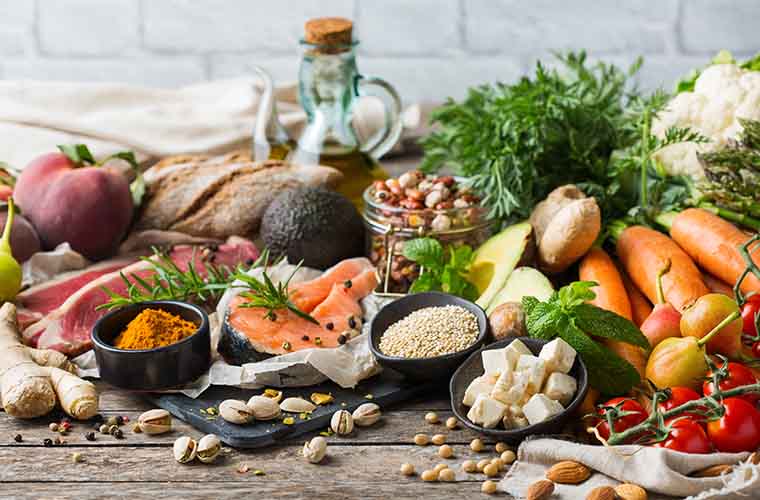Six Tips for a Heart Healthy Diet

The saying “you are what you eat” rings especially true when it comes to heart health. Good dietary habits are some of the best things you can do to improve heart health and fend off heart disease. Dr. Laura Arline, MD, chief quality officer at BayCare, offers six tips for a heart healthy diet.
Eat More Fruit and Vegetables
Incorporating plant-based foods is a first step towards promoting heart health. In the process, aim to limit your consumption of high-calorie foods such as meats and cheeses.
“Fruits and vegetables are both low in calories and high in fiber,” says Dr. Arline. “Plant-based diets are rich in nutrients that can help prevent cardiovascular disease.”
Not all fruits and vegetables are created equally. Fried vegetables, canned fruits in heavy syrup, and some frozen fruit with added sugar should be limited. Make sure to check the label at the grocery store.
“Otherwise, you may end up buying something you think is healthy but actually has added sugar or fat,” Dr. Arline says. “Fruit and vegetables should contain one main ingredient, and that’s the fruit or vegetable itself.”
Limit Unhealthy Fats
Fats play an essential role in human health. That said, there are two types of fats to be mindful of when thinking about your diet: saturated fats and trans fats.
Limit saturated fats found in animal products such as bacon and other fatty meats, cheese and whole milk, and coconut and palm oil to about 5% of your daily calories or about 10 grams from a 2,000-calorie diet. Trans fats, on the other hand, should be completely avoided.
“I don’t use the word ‘avoid’ very often in dietary advice, but I recommend you avoid trans fats entirely,” says Dr. Arline. “Trans fats tend to build up and cause plaquing that can clog the arteries, putting you at higher risk of heart attack or stroke.”
Dr. Arline suggests the following foods with “unhealthy” fats should be limited: butter, whole fat dairy products, bacon, fried foods, and processed foods such as chips and donuts.
On the other hand, the following foods with “healthy” fats are good substitutes: olive oil, avocados, nuts, seeds, and margarine.
Choose Whole Grains
Whole grains are a staple of a heart healthy diet. Offering great sources of fiber, they help regulate blood pressure and help you to feel fuller for longer, making it easier to maintain a healthy weight.
“Whole grains are good for the whole body,” says Dr. Arline. “The high fiber benefits heart health and keeps things moving through your gastrointestinal track, so you don’t get backed up.”
Many breads are colored brown to look whole grain even though they’re not. So, make sure to check that a product is labeled as “whole grain.” Better yet, read product labels and the choose foods that have higher fiber. Brown rather than white rice. Whole wheat pasta rather than white pasta. Steel-cut or rolled oats instead of the instant oatmeal.
Cook at Home and Plan Ahead
There’s nothing like a home cooked meal. Not only does it taste great and help save money, but it gives you better control over your ingredients and allows you to eat healthier meals with less additives and preservatives. Cooking at home takes planning, so Dr. Arline suggests creating a weekly menu to help lighten the load. Plus, she says, cooking at home can be a fun family activity. Mealtime is an ideal learning opportunity for families to develop healthy eating habits.
“For families with older children, maybe even get them engaged in some of the cooking tasks,” Dr. Arline says. “That’s a great way to teach them heart healthy skills that can last into adulthood.”
Serve Smaller Portions
Portion control is key to maintaining a healthy weight and heart healthy diet. “Just knowing what a portion size looks like can be helpful,” says Dr. Arline.
A good rule of thumb for a single serving of dry pasta is about two ounces (about the size of a quarter). For meats, a healthy serving is around three ounces (about the size of a deck of cards).
“You aren’t as limited by portion size when it comes to eating fruits and vegetables,” Dr. Arline says. “Fruits and vegetables have much fewer calories than starches and meats, and they’re more nutrient dense. That means you have more leeway with your portion sizes if you eat mostly fruits and vegetables.”
Cooking at home can also help with portion control because you can choose smaller plates and therefore eat smaller portions. Restaurants tend to overfill plates, says Dr Arline, which makes it easier to overeat.
Treat Yourself Occasionally
“You don’t have to be perfect,” says Dr. Arline. “Just follow the other five tips most of the time. Indulging every now and then is very human and totally reasonable. It may even help you stick to your healthy eating plan the rest of the time.”
